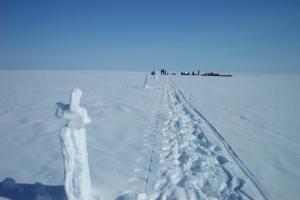14 April, 2002
Snow has fallen on the ground. You, as an excited child,
decide to dig until there is no more snow, just the ground
showing. Perhaps it is a snow cave or snow pit. Perhaps, it
is just fun to move all of that snow. Have you ever
stopped just for an instant to look at the snow? There is
an entire beautiful world within those layers of snow.
Matthew with his doctor's box knows this world of snow very
well.
The whiskbroom is used to brush away the loose snow and
reveal the individual layers. The measuring ruler is
unfolded to measure the height of each layer. Each layer
holds different qualities. Some layers have been melted
due to higher temperatures. Some layers have been hardened
by the howling winds. Some have been re-crystallized due
to temperature and humidity changes. All of this has
occurred within the winter season. The oldest snowfall is
deposited on the bottom of the snow pack. The youngest
snowfall is deposited on the top of the snow pack. The
snow has fallen and changed throughout the snow season.
Think of the snow layers like sedimentary rock layers. The
rock layers are deposited on top of one another. The rocks
have changed through time depending on the conditions.
Each of the rock layers indicates the geologic conditions
at that given time in history. The older rock layers are
situated on the bottom. Whereas, the younger rock layers
are situated at the top.
WHERE IS MRS. CHEUVRONT???? LET'S PLOT!!!!
Latitude: 68.48202 degrees North
Longitude: 155.75247 degrees West
We still set in the snug Ivotuk cabin. Fog and wind-blown
snow encircled the cabin for the duration of the day. A
whiteout was occurring where the visibility is limited due
to the dense fog and light snow. I set out doing a 5-mile
GPS/Magna Probe line. My eyes stayed focused on the
snowmachine tracks in front of me, which at times were
barely visible. The wind-blown snow stung my face. The
snowshoes were troublesome with the heavy, awkward, but
warm bunny boots. I was alone in the Arctic with the white
mountains surrounding me. The only sounds were the
snowshoes crunching the snow and the beeps of the
MagnaProbe. It was a long, immense, white walk, filled with
many, many scientific measurements. The measurements took
me 5 hours in which 944 snow depths were recorded.
Tonight will be our last night in the safe, comfortable,
isolated Ivotuk cabin. Tents will once again become our
home. We leave tomorrow for our long stretch to Ataqsuk.
We will leave the mountains in our background. The coastal
plains lie ahead of us. Our route will take us eventually
to Barrow at the edge of the Arctic Ocean.
Temperature Max: -14 degrees Celsius
Temperature Min: -21 degrees Celsius
Matthew Sturm
USA-CRREL-Alaska
P.O. Box 35170
Ft. Wainwright, AK 99703
907-353-5183
msturm@crrel.usace.army.mil

Looking down the end of a 100 meter line. Each of the snow sculptures represent a quick snow pit that was dug.

Inside a snow pit.
Contact the TEA in the field at
.
If you cannot connect through your browser, copy the
TEA's e-mail address in the "To:" line of
your favorite e-mail package.
|
